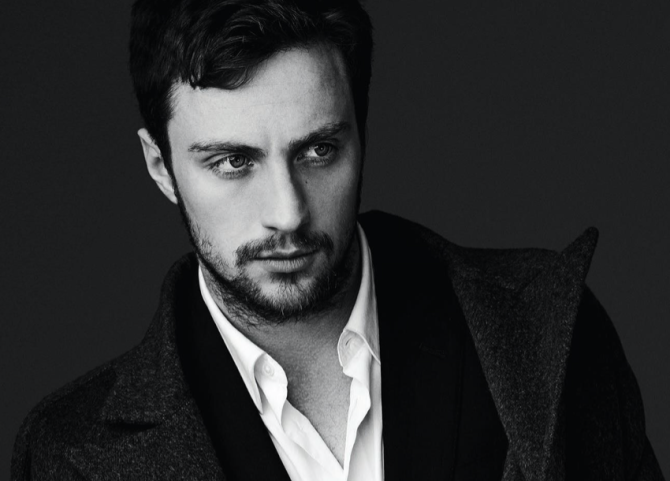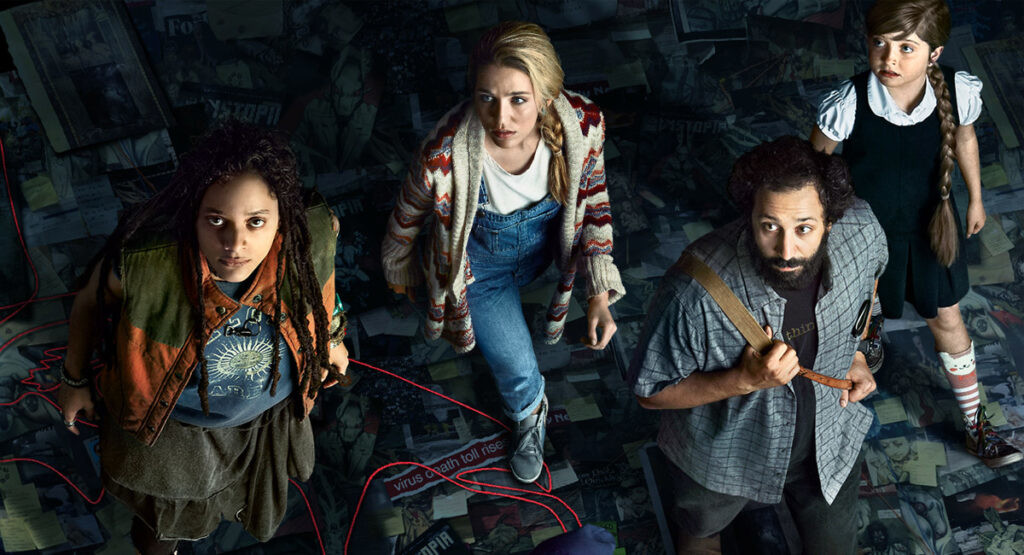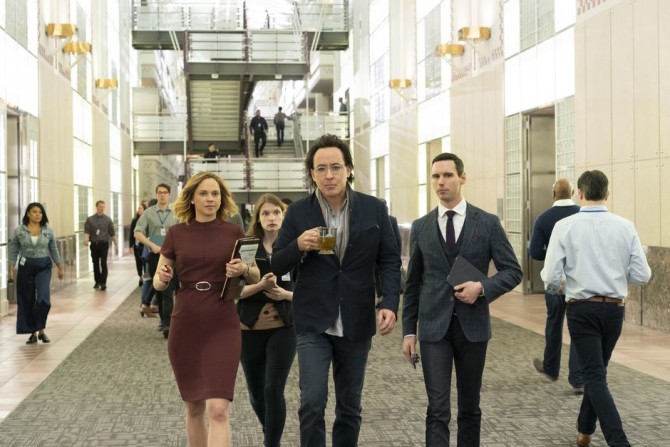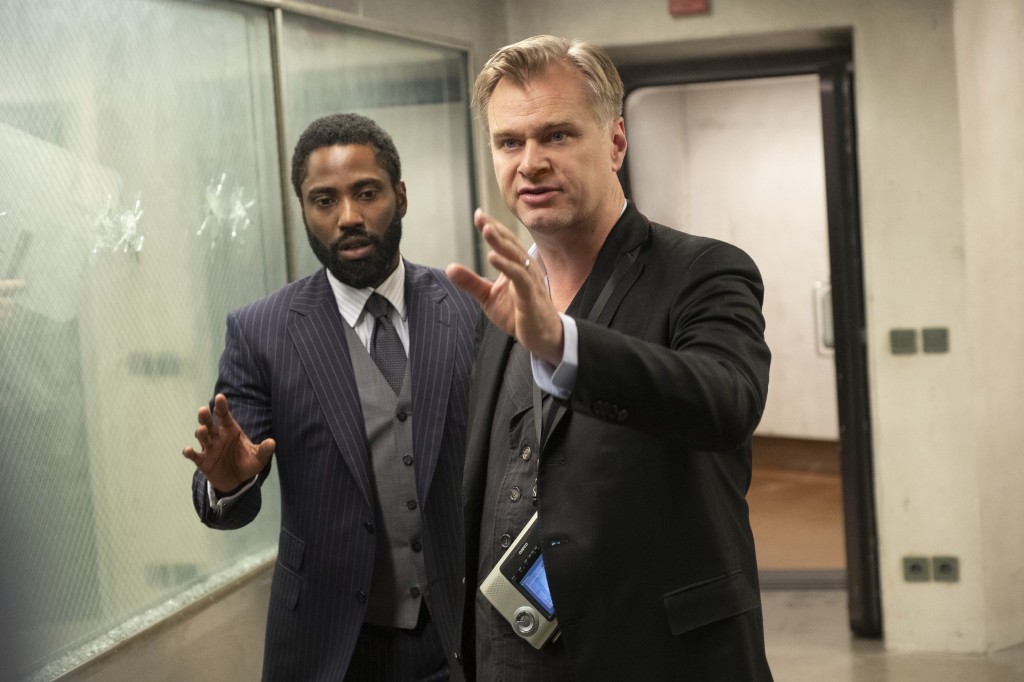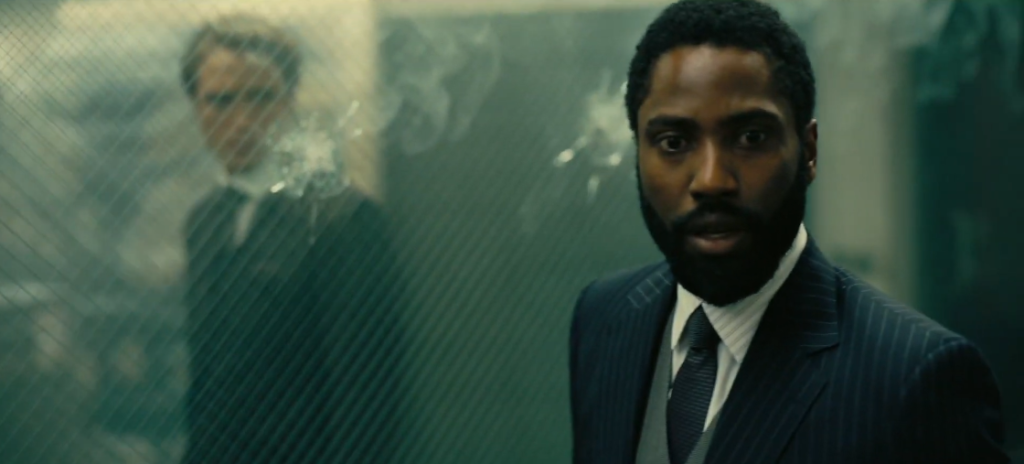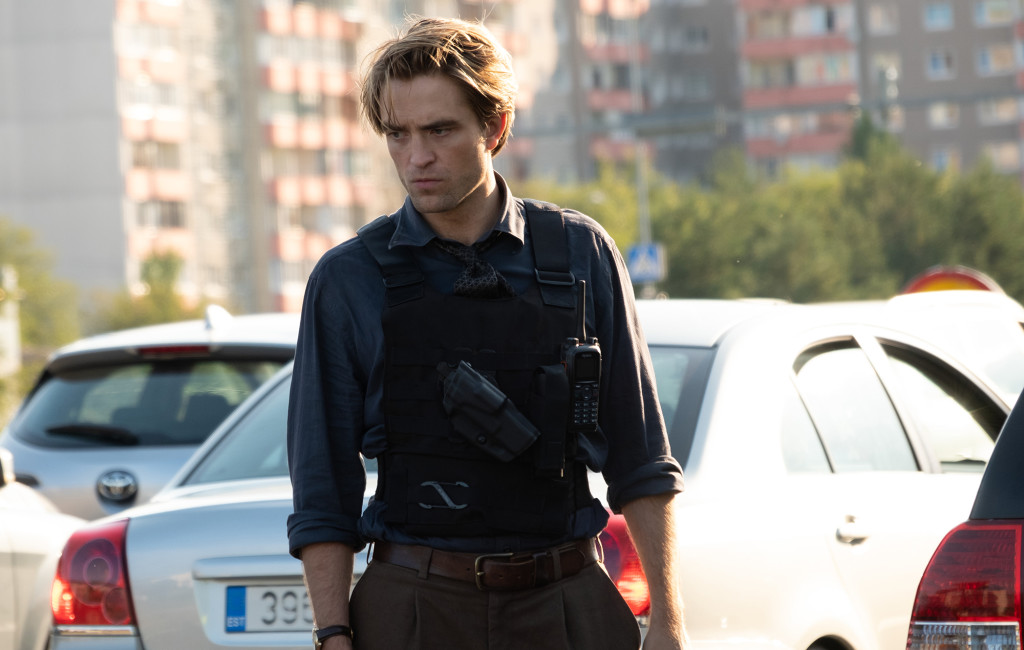Search Results for: F word
Million dollar spec Tuesday! wooooooo-heeeeee!
Genre: Spy Thriller/Period
Premise: The origin story of MI:6, Britain’s secret intelligence service, that came about out of necessity after the horrors of World War 1.
About: I’d forgotten about this script, which sold for a million bucks back in 2013. I was reminded about it recently when I saw that the writer, Aaron Berg, was in the news for his Atlantis project that sold to Netflix and is teaming him up with Batman director, Matthew Reeves. The reason Section 6 hasn’t been made yet is said to be that the Bond franchise is prickly about the similarities between the project and its own famous spy character. The two were going to go to court over the matter but Bond got cold feet when they realized that, by going to court, they would have to define exactly what makes James Bond “James Bond,” potentially offering a blueprint for other studios to “write around” those tenets and create a bunch of James Bond clones. We’ll see what ultimately happens but with the movement on this other Berg project, expect Section 6 to gain new life.
Writer: Aaron Berg
Details: 122 pages
Scripts like Section 6 aren’t easy reads. They’re sort of like mini-novels with the more extensive world-building, lots of history, and longer descriptive paragraphs. Outside of readers who love the subject matter, these scripts are often met with a groan because the reader knows the read is going to take twice as long.
Why?
Well-written spec scripts have a lot of white space. A lot of dialogue. This means your eyes fly down the page. There’s nothing anyone who reads scripts for a living loves more than their eyes flying down the page.
So what do you do if you’re a writer who likes to write this sort of stuff? How do you overcome this reader bias? Six simple words: Make sure your script is good.
We open on the British Embassy in Russia in 1918. World War 1 has recently ended. It’s a different world we’re told by many a character in Section 6. Ain’t that the truth. A Russian officer charges into the British Embassy being trailed by a bunch of mean Russian soldiers. Those Russians not only kill the officer, they kill all the British workers as well!
Not long after this, a British spy named Thomas Hawthorne heads to the Embassy to retrieve a secret piece of paper that’s been hidden. As soon as he gets it, though, the lights come on and standing there is this meanie named Ivan Vostok. Ivan grabs him to take him back to his torture den to get him to decode the message on the secret coded piece of paper.
Back in Britain, we meet Mansfield Cumming, a former soldier (who now uses a cane) who directs MI-1, the British Foreign Intelligence Service. Cumming is informed by a then spry Winston Churchill that the secret piece of paper Russia now has is a list of Russian politicians to assassinate for Russian revolutionaries (that’s what the opening Russian soldier was running from – he’d just assassinated a high up Russian politician)! If they figure that out, Russia will most assuredly attack Britain.
Cumming’s job is to find someone to infiltrate the Russians and get that piece of paper back before they decode it! There’s only one problem. Britain’s spies at this time were all spineless rich wimps. They were good at hiding and sneakily exchanging information. But they couldn’t do the dirty work. Cumming needs someone who can do the dirty work.
Enter 23 year old Alec Duncan, a soldier who’d been smack dab in the middle of World War 1. If there’s anyone who saw dirty, it was this guy. Currently making his living pickpocketing pedestrians and cheating at poker, Cumming collects Duncan from jail after he’s caught by a local policeman.
You know what happens next. That’s right: training! Cumming helps Duncan ditch his soldier impulses and approach things like a spy would. You have to be sneakier. You have to be faster. You have to be strong under pressure. The only thing Cumming is worried about is whether Duncan, a brute at heart, can hang with high society types. So he sets up a test at a local upper crust function that ends with Duncan crashing two 1918 subway train cars. I’d say that’s a success, wouldn’t you?
After his training, Duncan is sent by boat to Helsinki (this is around page 72) where he meets up with another spy, a beautiful woman named Nightengale, and they sneak down into Russia, find a badly tortured Hawthorne, and get him out. But the Russians don’t give up easily, pursuing them all the way to the sea. Will our tiny team be caught resulting in World War 2? Or will Section 6 be born?
Section 6 is a solid script.
I’m not the biggest spy film fan. But when I do like spy films, it tends to be when they’re doing something differently. I like this angle of a time before spies could be spies. And this was the transition to get them from these polite hoity-toity wusses who got mad if they spilled wine on their shoesies to dudes with a license to kill.
This is always a good thing to keep in mind when it comes to concept creation. You don’t want to just look for subjects. You want to look for subjects in transition. For example, you could make a story about the train industry in the U.S.. Or you could make a story about the train industry during the birth of the American highway system. Because the highway system is going to make the train industry irrelevant, you’ve got a much more conflict-heavy playground to play in.
Disruptive forces are entertaining. Polite spies don’t work in the post World War 1 era where hundreds of thousands of soldiers’ lips have been seared off from exposure to chemical weapons. You need a dirtier spy, someone with a more varied, nastier, skillset.
The reason the script doesn’t get higher marks with me is because of the structure. We don’t send our hero out on his mission until page 72. This creates a second half of the script that feels rushed. For example, we’re meeting this primary character in Nightengale on page 75. Considering how well we know everyone else by this point, she feels paper thin and never quite makes sense for the mission.
Don’t get me wrong. I understand the writer’s dilemma. This is essentially an origin story. With origin stories, you need to lean into the whole learning process. When Spider-Man first gets his powers, you don’t send him after Octopus Guy five minutes later. Spider-Man must first learn how to use his powers, as well as balance out how these newfound abilities affect other parts of his life. That takes time.
I guess it comes down to if you’re an origin-story guy or not. Some people like getting into the nitty gritty of the origin. I just found it hard to reconcile that time was “of the essence” with the Russians getting closer and closer to cracking Hawthorne, and yet we’re taking weeks to train Duncan here. I understand it’s 1918 but still. The whole timing of the separate plotlines didn’t organically mesh.
I did like, however, that by making this a period piece, we got a more interesting McGuffin. These days, the spy film Mcguffins are all the same. They’re some variation of “the nuclear launch codes.” I liked that this was a list of assassinations to be made.
You have to understand, as a reader, we’re experiencing what you experience at the theaters, times 20. So every time you see “nuclear launch codes” in a movie, I’ll read 20 scripts with “nuclear launch codes.” Which means I’m easily turned off by any highly used trope. In contrast, I value writers who change these tropes up. And one of the easiest ways to change tropes is to do it at the concept level. Take us to places we don’t normally go. Naturally, when you do this, you’re going to find things you don’t normally find.
It’ll be interesting to see what happens with this because it’s one of the better scripts I’ve read in the genre in a while. But it does seem to have this giant hurdle to leap in the looming Bond Producer Brigade who are at the bridge, 24/7, shouting, “Though Shall Not Pass.”
And yes, I’m thinking the same thing all of you are thinking. Which is that I should’ve had Scott review this. :)
[ ] What the hell did I just read?
[ ] wasn’t for me
[x] worth the read
[ ] impressive
[ ] genius
What I learned: Section 6 has one of the more interesting Save The Cat examples. It’s “Befriend the Cripple.” Duncan is friends with a fellow soldier who got half his face blown off in the war and now wears a Phantom of the Opera type mask. It’s a bit cheap. But the love Duncan has for him is very effective in making us like him, especially because he’s a pretty harsh guy that isn’t the easiest to root for.
The word on the street is that Pascal is out. Gone. No longer a part of The Mandalorian. He left mid-season because they refused to give him scenes with his helmet off. Ya gotta give it to Star Wars. This franchise loves drama.
How weird is this development? Well, it comes after learning, in the first season, that Pascal wasn’t even around for the show. They had John Wayne’s son in the Mandalorian suit instead (this is real! Look it up!).
So you’ve managed to make someone quit… who wasn’t even officially on the show. Only Star Wars, man. Only Kathleen Kennedy.
But let’s get to the trailer for season 2. Was it any good? It was pretty good. The Mandalorian is the closest thing so far to the original trilogy so it’s got that going for it. I love Baby Yoda putting up his “stroller shield.” That was fantabulously cute. I like the opening shot of a damaged ship. Not sure I’ve ever seen that before in a Star Wars property (not done like that, anyway). There isn’t a money shot but the trailer is solid. All Star Wars trailers are solid.
If you remember, I soured on The Mandalorian for two reasons. The lack of story connectivity was frustrating. Making this a pseudo anthology series goes against the connective tissue that helps make Star Wars so great.
But more frustrating was this choice to recruit second-tier Star Wars concepts from such shows as the animated “Star Wars: Rebels.” You’ve got our series villain now wielding something called the “dark sabre” which is such a dumb weapon concept I refuse to beleive it came from anyone over the age of eight.
The Mandalorian didn’t market itself that way. This is the series that started off with storm trooper helments on stakes. This is the series that opened up with a decapitation scene in a bar. Now we’re importing ideas from shows where every other character chimes in with a “I’ve got a bad feeling about this” before commercial break?
Star Wars is better than that.
And yes, I realize this is the franchise with little booping robots, characters named “Dooku,” and a giant slug for a villain. How is the dark sabre any different? I don’t know. I just know it is. This is why Star Wars has been so hard for so many creators to nail down. There are these indefinable variables that each fan has worked into their own “This is what Star Wars is” equations.
I will probably watch the series because the episodes are short and there’s bound to be one or two good episodes in the mix. Oh, and since Pascal is no longer around and there’s a rumor that Boba Fett is back from the dead, it might be fun to have Boba Fett kill the Mandalorian and slip into his armor moving forward. Talk about dramatic irony! We know this is Boba. But nobody else does.
That could get me back permanently. :)
Genre: Drama/Sort of Supernatural
Premise: When the sequel to a fringe graphic novel masterpiece unexpectedly emerges, the lone copy draws a group of superfans from different walks of life to buy it in a one-day only auction.
About: We have some weird connections to yesterday’s World War Z 2 review. This show is based on a British show written by Dennis Kelly. Who wrote yesterday’s script? Dennis Kelly. This script is written by Gillian Flynn. Gillian Flynn adapted her own book, Gone Girl, for David Fincher, the man who was supposed to direct Dennis Kelly’s script for World War Z 2. Did you follow all that? The show has recruited John Cusack, Rainn Wilson, and Happy Death Day star, Jessica Rothe. It will premiere on Amazon Prime.
Writer: Gillian Flynn (based on the original show created by Dennis Kelly)
Details: 65 pages
When it comes to TV shows that have the potential to be great, HBO has re-taken the pole position. You may remember when AMC and FX had some really great shows. And even Netflix, for a while, until they went algorithm crazy, favoring wackadoodle experiments such as The Floor is Lava, over the next House of Cards. So when they put something into production, I pay attention.
And yet, somewhere along the way, HBO gave up on Utopia. This happens quite a bit. HBO has a TON of shows in development and only lets the cream of the crop into the on-air lineup. Which leaves us to wonder if Amazon Prime is receiving a 1998 Chevy Impala with a bad transmission or a 2020 Tesla with some of them bulletproof windows. Let’s all hope it’s the latter. Cause I need a new show to watch!
After inheriting her grandfather’s cabin, Olivia and her hubby, Ethan, find a dark disturbing graphic novel in his home titled “Utopia.” Ethan looks it up online and realizes that it’s a sequel to the small but fiercely loyal fanbase of a graphic novel titled “Dystopia.” Figuring this might mean some *ka-ching*, Ethan posts online that he’ll be selling Utopia to the highest bidder at FringeCon this weekend.
Over the next 30 pages, we meet all the players. There’s hot Samantha, who’s a super hardcore Dystopia nut. There’s Wilson Wilson, an intense private guy who thinks the whole world is after him. There’s Grant, a 10-year-old kid. There’s Becky, who has a rare disease but is in a relationship with fellow Dystopia obsessive, Ian, who lives with his grandma.
All of these people know each other online due to their intense love for Dystopia. But none of them have met in real life. They don’t even know that Grant is 10. They think he’s a photographer for supermodels. That’s about to change since they agree to all get together at FringeCon and bid on Utopia.
On to FringeCon we go, where Olivia and Ethan have set up a hotel room where bidders come in one at a time, get to look at a single page from the book, then make a bid. Highest bid wins. By the way, this is where I should tell you that everyone in the group believes Dystopia predicts the future. It’s predicted numerous pandemics since it came out. And the sequel is said to have bigger, more dire, predictions.
Everybody makes their bid but no one here is rich. The highest bid doesn’t even crack 1k. So it sucks for them when the well off Carson (as far as I know, no relation) shows up and says he wants to take the comic off the market… for 20 grand! Ethan and Olivia say, “Ka-Ching” and sell it, thinking they just made out like bandits.
Except that a couple of hours later, two sketchy-looking dudes, Arby and Rod, show up demanding to know where the graphic novel is. They inform them Carson bought it. He’s in the penthouse. That’s not enough for them. They want to know everybody who looked at it. (spoilers) Ethan and Olivia get the sense that these aren’t a couple of angry buyers. These are dangerous people. Their sense is correct, cause Arby and Rod kill them. They then head up to the penthouse, where they learn of a disturbing development. Grant, the 10-year-old kid, has stolen it. And he’s getting away. To be continued…
Utopia makes a bold choice here in deviating from the original. In the original, we start out with a gruesome murder. Flynn, however, uses the first 45 pages to set up characters. There’s barely any story or plot. It’s us meeting character after character.
Now you may say, wait a minute Carson. You told us never to do this. Why does Gillian Flynn get to do it? Well, here’s the thing. You don’t have to add any plot to the first 40 minutes of your pilot script either. But if you’re going to go down that road, you better…
a) be really good at character creation.
b) be really good with dialogue.
Gillian Flynn is good at both. Plus, she has an advantage. She’s working with established material which already did some of the heavy lifting for her. It was a character-centric show, so she has the baseline for her characters set. Also, any character who didn’t work in the previous show, she can get rid of and replace with a character she thinks up. That’s a nice luxury to have when you’re writing something. Because, in my opinion, character creation is the hardest part of writing.
The point is, if you’re not using plot to hook us, you need to have been told numerous times that your character writing is strong and/or that your dialogue is strong too. Because they’re what’s going to be front and center without plot. And even if they’re “kind of good,” readers are going to tune out. The characters need to be “really good” or better.
Now what I found interesting about Flynn’s Utopia was that it took the opposite approach to Kelly’s pilot. Kelly put the first kill scene in the pilot’s teaser. Flynn puts her first kill scene all the way at the end of the pilot.
Which of these is the better choice? Do you kill right away? Or do you LEAD UP to the kill?
Each has a different effect on the audience. If you kill in the opener, it immediately grabs our attention. But then it’s gone. We can’t use it again. Or, if we do, it’s not as surprising anymore and, therefore, less impactful.
When you lead up to a kill, it gives the reader something to look forward to. If we establish that Arby and Rod are bad guys looking to do bad things and they’re on their way to FringeCon, we the reader are pulled along by a powerful line of suspense. We know that these two bad guys are going to collide with our heroes, which means we’re going to keep reading to find out what happens.
The downside of this choice is, not a lot of exciting things are going to happen prior to this collision. This means the reader is mainly reading setup and exposition. Not exactly the most riveting story experience.
Still, I would say that the second option is better because you get much more out of it. You get all that ongoing suspense. Whereas, if you kill right away, you suck up some of the story’s air. We’ve already seen the worst. It’s like that bad movie, U.S. Marshalls, the unofficial sequel to The Fugitive. They had that amazing plane crash scene in the opener and then nothing else in the script came close to it.
The problem is Flynn’s Utopia doesn’t take advantage of the second option. It never implies that the kill is coming. It doesn’t even imply the bad guys are bad. So we don’t get any build-up of that suspense, of that anticipation. Which means the kill is a surprise.
In screenwriting, you want to get the most bang for your buck out of every plot development. If the only entertainment we get from a scene happens within the scene itself, you’re leaving a ton of entertainment on the table. The right move would’ve been to heavily imply that Arby and Rod were going to do very bad things, which would’ve gotten so much more out of this plot point. As it stands, we get that surprising kill and— then it’s done.
But like I said, the characters are all really strong here. So I still enjoyed the experience. I still want to see what happens next.
Oh, and I wanted to give you guys a THIRD VARIABLE example from Utopia since I talked about that last Thursday. When Olivia and Ethan first find the book, they need to figure out what the book is. So they go on the internet on his phone. Now, we could’ve stopped there. He checks Google. Google tells them. Exposition handled. Scene over. But because they’re out in the middle of nowhere, Ethan keeps losing the connection in the middle of a Youtube explanation of what Utopia is. This is the THIRD VARIABLE that makes the scene more interesting. The explanation keeps stalling, forcing them to keep moving, creating more suspense, and making what could’ve been a boring straight-exposition scene into something a little more dramatic.
This show could be good assuming episodes 4-10 don’t devolve into “running around with your heads cut off” storytelling. I hope Flynn has a plan for that!
[ ] What the hell did I just read?
[ ] wasn’t for me
[xx] worth the read
[ ] impressive
[ ] genius
What I learned: “Olivia, hair now pulled pragmatically back in a bandana…”. This is an early description in the script. The funny thing is that I read it as “dramatically” instead of “pragmatically,” which created a different image in my head. Like she really went all out on putting her hair back. But when I realized it was “pragmatically,” I thought, “Oh, that’s more straight-forward,” and my image of the visual changed. This reminded me how much words matter when describing things, particularly adverbs. And how you can use them to change the tenor of the image. Note how all of these adverb substitutions create different images in your head, as well as make you think of Olivia differently.
“Olivia, hair now pulled lazily back in a bandana…”.
“Olivia, hair now pulled carefully back in a bandana…”.
“Olivia, hair now pulled defiantly back in a bandana…”.
“Olivia, hair now pulled playfully back in a bandana…”.
“Olivia, hair now pulled sharply back in a bandana…”.
“Olivia, hair now pulled joylessly back in a bandana…”.
“Olivia, hair now pulled painfully back in a bandana…”.
I read so many scripts where I never get any sense of the characters at all. Little things such as including the perfect adverb can help solve that problem. Not to mention, it’s a lot of fun trying to find the right adverb.
Genre: Sci-Fi/Spy Thriller
Premise: (from IMDB) Armed with only one word, Tenet, and fighting for the survival of the entire world, a Protagonist journeys through a twilight world of international espionage on a mission that will unfold in something beyond real time.
About: Tenet has had a complicated release journey. There was all this behind-the-scenes talk about how Christopher Nolan wanted Tenet to be the film that saved the movie business. He wasn’t just releasing this for Warner Brothers. He was releasing it for the world! But it’s said Nolan nearly had a heart attack when it was suggested that Tenet would need to be played in – GASP – drive-in theaters! All of a sudden, Nolan considered waiting until the pandemic was over. In the end, the movie was forced into an unenviable staggered release pattern. Some places would get it, some wouldn’t, which would make box office boasting – a key marketing tool for studios – difficult. Tenet isn’t even playing in my home town, Hollywood. How ironic is that? I had to travel down to San Diego to see the film. But see the film I did.
Writer: Christopher Nolan
Details: 150 minutes
Tenet.
It’ll open the right doors.
Some of the wrong ones too.
That’s a line from the movie. Which is apropos considering Christopher Nolan himself has opened some of the right doors with Tenet, but also many of the wrong ones.
The Protagonist (yes, that’s our hero’s name) is a CIA agent who tries to kill himself via a suicide pill rather than give up his men. But it wasn’t a suicide pill. It was a test. To see who was willing to go the distance. Now that he’s proven his worth, he’s been recruited into a next level mission. It’s called Tenet. Unfortunately, that’s all he’s told. I guess the Protagonist will have to figure out the rest on his own!
He eventually meets up with a female version of Morpheus who explains what “tenet” is – it’s time inversion. The secret tenet gatekeepers keep finding these small artifacts – such as bullets – that do things backwards. So instead of shooting the bullet, you “receive” the bullet back into the gun. Female Morpheus doesn’t know where these artifacts are coming from. That will be the Protagonists’s job.
A lot of stuff happens here but, long story short, the Protagonist bumps into a sloppy drunk named Neil, who may or may not work for a secret organization, and the two interrogate the manufacturer of the inverted bullets, a billionaire Indian woman named Priya. It turns out these bullets are being manufactured in the future. So Priya doesn’t even know she’s manufactured them yet (or does she? Tenet).
All signs of these inverted weapons point to a Russian oligarch named Andrei Sator. Sator is so big time that the Protagonist’s only way in is through his wife, Kat. Kat hates Sator, so there’s an opening there. She’s only still with him because he refuses to give her her son if she leaves. To prove his value to Kat, the Protagonist steals a painting for her. Okay, she says, she’ll introduce him.
The details are complicated, but to sum it up, Sator is secretly receiving gold and inverted weapons from his future self. This is what’s allowed him to become so freaking rich. He has also been searching for seven deliberately hidden pieces of a super weapon in the past from the future (Tenet). Once he finds all seven pieces, he will activate them, creating a super-inversion situation whereby the present and future will collide and the world will be destroyed.
Sator momentarily lets the Protagonist into his inner circle when he learns that he knows about tenet. Meanwhile, the Protagonist’s buddy, Neil, is looking for that seventh and final piece to the Wand of Inversion. They must get that final piece before Sator does. It’s the only way to stop the extinction level event. But then everything is complicated when it’s revealed that Sator has rigged himself so that if he commits suicide, the inversion event will happen automatically. I think. You think. Maybe. Maybe not? Tenet.
The one inarguable thing I’ve always said about Christopher Nolan is that he’s a great filmmaker.
He shoots everything in camera. There are no special effects. He’s said in numerous interviews that he believes the audience can feel when something has been done for real as opposed to with computer graphics. And I agree with that.
He casts his movies well. Everybody here is awesome. John David Washington is the perfect 2020 movie star. He’s got that screen presence a movie star needs yet he’s not too masculine. He almost has this cool feminine side to his demeanor that balances him out, making him easily accessible to audiences. I’m in love with Elizabeth Debicki. On the contrary, there’s something almost inaccessible about her that makes her alluring. She may be the perfect female star for a Christopher Nolan film. Kenneth Branaugh is over the top here, but my desire to see Sator go down proves that whatever he was doing was effective. Even Robert Pattinson was solid. He certainly looks good in those suits they dressed him up in.
And just the production value of a Christopher Nolan movie is so impressive. There was this moment around the halfway point where the characters are all out on one of those double-pontoon sailing skiffs. That scene did a better job of transporting me to another place than anything I’ve seen so far this year. Cause, to me, that’s what a Hollywood movie should do. It should take you to places you’ve never been. Show you things you’ve never seen.
And as much grief as I give Nolan for his pretentious film school approach (I mean who titles their main character “The Protagonist” other than an insufferable pretentious film school student? Come on.), he’s literally the only mega budget filmmaker making his own stuff. Without him, it’s all Disney and Marvel folks.
Maybe that’s why it’s so frustrating that Tenet didn’t work.
I fear that Nolan is approaching George Lucas level bubble territory. That elusive world where nobody says ‘no’ to you because of how successful you are. And this is the type of movie that requires a strong “no” person. It’s such a heady concept that if you don’t have people in your circle saying, “I don’t understand that, it needs to be clearer,” the movie isn’t going to work. And that appears to be what happened.
I mean there’s this moment early on where Female Morpheus is explaining to the Protagonist how inversion works. She hints at this idea of a Matrix like situation. That you can control this power. He tries to make the bullet come up to his hand but it won’t. “You have to drop it first” she says. He tries again, this time the bullet comes into his hand. But he didn’t drop it. She literally said, “You have to drop it first.” And he didn’t drop it and it still came up to his hand. The fact that nobody stopped to ask if the audience would be confused after that moment encapsulated what was wrong here.
The insurmountable issue with Tenet is that “inversion” is a difficult concept to understand. The more you think about it, the less it makes sense. That’s why you’re getting so many reactions that describe the film as “frustrating.” Because people don’t understand how the central concept of the film works.
One of the reasons the Matrix was so great was because its central concept was so easy to understand. “We’re unknowingly living in a virtual reality.” Boom. Understood! Tenet is the opposite. Even right now, as I’m writing this, I’m trying to figure out if inverted objects work under a different set of rules than inverted people. Aren’t inverted people on a pre-set tape? They’ve already gone that way (backwards), so there’s nothing you can do to stop them. These objects, however, you seem to be able to do unique things to them on a repeatable basis. Make them go backwards into your gun over and over again, for example. How does that make sense?
Nolan only makes things harder on himself with a borderline incomprehensible plot. I could take a UCLA course on why the Protagonist needed to a) steal a painting and b) do it by crashing an airplane and still not understand the logic, or what it had to do with the rest of the movie. He only exacerbates this issue by extending the film out to two and a half hours. It gives the audience even more time to get lost.
Maybe the best representation of what went wrong with this movie was the climax. In theory, it was a fun idea. You’re using both regular and inverted soldiers to obtain the final piece of the staff. I love that idea. But that’s all it ended up being, an idea. The actual execution was bizarre. We’re seeing soldiers head onto the battlefield while, simultaneously, soldiers leave the battlefield via the inverted timeline. They had already been through the mission.
So my first thought was, “Well then you already know you were successful, right?” But then I thought, “Wait, those are the different soldiers. Not the same ones.” “Or wait, are they the same soldiers?” The fact that I was still asking these questions this late in the game confirms how poorly the rules were explained to us. Because, at this point, I should be enjoying the moment. Instead, I’m trying to make sense of it all.
Nolan needs a “No” man moving forward or he’s in danger of becoming a parody of himself. A lot of us saw this as far back as Inception, which relied too heavily on exposition. Then came Interstellar, which had a lazy wonky structure. And now this. An idea that doesn’t even work at the concept stage.
Look, Nolan is a great filmmaker. Nobody argues that. But he needs to take a hard look in the mirror when it comes to his writing. He’s not doing himself any favors there. The one clean narrative he’s had out of his last four films was Dunkirk and the reason for that is that the timeline was simple. Everything happened on the same day. Moving forward, focus on what you’re good at – the directing side. But when it comes to writing, unless you’re going to hire people whose professional job it is to write, don’t do any more of these overly complicated concepts with sprawling narratives. They don’t hold together.
[ ] What the hell did I just watch?
[x] wasn’t for me
[ ] worth the price of admission
[ ] impressive
[ ] genius
What I learned: You want your ending to be the biggest exploitation of your concept of the entire movie. Tenet got this right. The movie is about time inversion. So what better an ending than throwing both regular AND inverted soldiers at the enemy? Sort of an “attack on the Death Star” but with multiple timeines happening at once. The only reason it didn’t work was because the concept was weak to begin with. But this is the right move as a screenwriter. If your movie is about dinosaurs on an island, your climax better deliver the best dinosaur versus human situation we could possibly imagine. It shouldn’t feature a plane crash.
Genre: Horror
Premise: A mother and her twin teenage sons live in a remote cabin where they’ve developed a system to protect themselves from the evil that has destroyed the rest of the world.
About: Shawn Levy can’t get enough! Even after becoming Netflix’s number 2 man behind Reed Hastings, the Stranger Things producer wants an even bigger piece of the entertainment pie. This time he’s teaming up with Lionsgate to produce today’s spec script, written by newbies Kevin Coughlin and Ryan Grassby. Yes, Coughlin and Grassby have a couple of produced credits, but come on, one look at those credits and you know they had nothing to do with this sale. I’m pointing this out as a reminder that it’s possible for all of you to break in with a spec script. Never give up. Never surrender!
Writer: Kevin Coughlin & Ryan Grassby.
Details: 103 pages
Are crazy moms the new trend??
I dunno.
First Raised by Wolves and now this! I’m sure it’s only a matter of time before we get a coalition of mothers marching down Sunset Boulevard infuriated about their stereotyped representation in film. Until then, let’s all enjoy the craziness. Because it’s oh so boring when everything is running smoothly, don’t you think?
Momma lives in a remote cabin in the woods with her 14 year old twin boys, Nolan and Samuel. We can tell right away that something’s up. They have to pluck crickets, pick plums, and and set squirrel traps just to eat. Nothing like a plum squirrel sandwich.
Oh, and they all wear ropes around their waists that are tied to the house. Nobody can ever go anywhere without a rope. They’re like Motherland’s version of corona masks. Except instead of being shamed on Twitter, you’re killed.
By who?
That would be the “evil.” The “evil” is what destroyed the rest of the world, leaving this family as the only three human beings left. Luckily, Momma figured out how to defeat Evil. You have to always wear a rope. Lose the rope and Evil will snatch you up and pull you away.
Whereas Samuel is Team Rope, Nolan has lots of questions about the ordeal. Just how far has Mother looked? Is she SURE they’re the last people on the planet? Mother says she is absolutely sure.
However, things get real when Momma dies and they start starving. It would sure be nice, Nolan thinks, if they could go beyond the radius of these stupid ropes to look for more food. One day, he’s had it. So he goes to the edge of his rope and screams, “Help!”
Twenty minutes later, a hiker shows up. He sees the emaciated Nolan and tells him he can help. Let’s get you back to my truck. Just then, Samuel shows up with his crossbow. He tells the man, who he believes is the Evil, to leave. Confused, the man pleads his case, only to be shot.
Nolan and Samuel will have to figure out soon which worldview is the real one. Cause either more people are going to show up looking for this man, or Evil in Disguise is going to keep coming until it’s tricked and murdered them. The day of reckoning is near.
One word I’d use to describe this script?
Ambitious.
I wouldn’t have said that when I started reading it. But by the time I finished it, I realized there were a couple of complex themes being explored. Were those themes explored successfully? I’ll get there in a second. First, let’s break Motherhood down.
Here’s what I liked about the script. It built its entire structure around your expectations. Remember that awful M. Night movie, The Village? The one where a bunch of people are living in the year 1850, deep within a forest village? Then, at the end of the movie, we realize they’ve all been tricked and it’s actually present day?
Motherland could’ve done the same thing. Instead, it leans into the possibility that the children are being lied to. That makes us think, “Oh, we’ve been down this road before. It’s another Village situation!” This makes us feel smart, like we’re ahead of the story.
But then, just as we believe that the big reveal will be made and we can throw our hands up in victory: “See! We knew all along! We’re movie cinephiles!!!” Instead, Coughlin and Grassby start throwing in doubts that we’re living in the village. Maybe, just maybe, Mother was being truthful the whole time.
This is what saves the script. Because now, in these final 30 pages, you’re not sure which is true. Were the kids lied to or is there really an “evil?”
On top of that, Motherland explores the theme of perception in a very thoughtful way. All of us are the sum of our influences. Our parents, our friends, our faith, the things we read, the news we consume. All of that forms our belief system – how we see the world.
Motherland strips that down so that there’s only one influence – her. And what that does is it allows us to see how powerful influence can be. If you’re a kid who’s only ever known one parental figure and, therefore, they are the only one providing you with a worldview, it’s possible for you to have a completely incorrect worldview despite the fact that you’re positive it’s the right one.
That reality alone is a horror movie.
Because think about it. That’s exactly what’s going on right now. We’re all following our own “Mothers” who are giving us all the “correct” information, and we’re basing our entire approach to life around that. And many of us, despite not knowing it, are dead wrong in our world view. And no, I’m not going to get into the specifics about who because it literally happens on all sides.
But the point is, by distilling everything down to one influencing variable, it puts a spotlight on the theme of influence so that we understand how powerful it can be.
With that being said, there were times where the script couldn’t stand on its own two feet due to its shaky rule set. For example, the ropes. Let’s think about this for a second. We’re told that the ropes are magical lassos protecting us from the “evil.” If your rope is cut, you are susceptible to being eaten or murdered or taken away by the “evil.”
This rule alone had issues. The mother can see Evil in physical form but the kids cannot? So wait. If the evil has the choice of not showing itself, which it clearly does since the kids don’t see it, then wouldn’t it choose not to be seen by Momma as well?
That would allow it the advantage of being able to sneak up on Momma whenever it wanted. Sure, staring at momma in the form of a creepy delusional old woman makes for a creepy moment. But it’s working against its own goal, which is to kill her. Every time you show me how scary you can be, I’m going to be even more diligent about making sure I don’t fall for your tricks.
But that isn’t the real part that bothered me. The real part was the rope carried a convenient dramatic safeguard for the writer. Had there been no rope, the kids would’ve easily been able to confirm whether there was a Walmart six blocks away. Which made me think back to the original purpose of the rope. Which is to protect each of them from Evil killing them.
So Evil can’t kill people if they have a *rope* around them??? What????
The more you thought about it, the less it made sense. And because that rule was a story pillar (a centerpiece for how the story operated), it weakened the over impact. Again, this is why A Quiet Place was such a perfect concept execution. No crazy conflicting rules. If you made a noise, you were dead.
I’m torn about Motherland.
It’s imaginatively sloppy, which is about as backward a compliment as I can give. But that rope stuff – I concede that that type of visual works well in horror. Combine that with the “evil” being able to take on many creepy forms and you’ve got yourself a really effective trailer. There may be something here. It’s enough for me to recommend the read. But just barely.
[ ] What the hell did I just read?
[ ] wasn’t for me
[x] worth the read
[ ] impressive
[ ] genius
What I learned: Have a character answer their own question – This is an old dialogue trick that I’ve always liked. At one point, Nolan asks Momma if what she’s saying about the world is true. Normally, these kinds of question and answer exchanges have NOTHING to do with the characters. They’re solely put there as a way for the writer to get exposition to the reader. The average writer would then have Momma explain what happened to the world to convince her son that, yes, it’s all real. Instead, Coughlin and Grassby have Momma give Nolan a stern look. Nolan then begins to recite the story *that mother has already told him dozens of times before about what happened to the world*. It’s all exposition but we don’t notice it as much when the character asking the question is also answering. For whatever reason, there’s something about when Character A asks and Character B answers that screams, “HERE’S EXPOSITION FOR YOU.” Cover that up with a character answering their own question.

